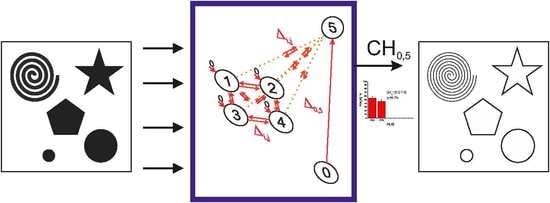A Method for Evaluating Chimeric Synchronization of Coupled Oscillators and Its Application for Creating a Neural Network Information Converter
Abstract
1. Introduction
2. Materials and Methods
2.1. Chimeric Synchronization Classification
2.2. Method of Chimeric Synchronization Color Mapping
2.3. Oscillator Circuit
2.4. ONN Structure
2.5. Task Setting And Technique of ONN Training
2.6. Method of Oscillators Coupling and Variants of Experimental Implementation
3. Results
3.1. Investigation of the Chimeric Synchronization of Two Coupled Oscillators
3.2. The Study of the Neural Network Information Converter, without Accounting for Chimeric Synchronization
3.3. The Study of the Neural Network Information Converter, Accounting for Chimeric Synchronization
3.4. Scheme of Converting with a Minimum Number of Couplings
3.5. Technological Concepts of Neural Network Converters
3.6. Examples of Image Processing
4. Discussion
5. Conclusions
Funding
Acknowledgments
Conflicts of Interest
References
- Callan, R. The Essence of Neural Networks; Prentice Hall Europe: Upper Saddle River, NJ, USA, 1999; ISBN 013908732X. [Google Scholar]
- Bishop, C.M. Neural Networks for Pattern Recognition; Clarendon Press: New York, NY, USA, 1995; ISBN 0198538642. [Google Scholar]
- Roska, T.; Chua, L.O. The CNN universal machine: An analogic array computer. IEEE Trans. Circuits Syst. II Analog Digit. Signal Process. 1993, 40, 163–173. [Google Scholar] [CrossRef]
- Swingler, K. Applying Neural Networks: A Practical Guide; Morgan Kaufmann Publishers: San Francisco, CA, USA, 1996; ISBN 9780126791709. [Google Scholar]
- Kuramoto, Y.; Battogtokh, D. Coexistence of coherence and incoherence in nonlocally coupled phase oscillators. Nonlinear Phenom. Complex Syst. 2002, 5, 380–385. [Google Scholar]
- Abrams, D.M.; Strogatz, S.H. Chimera states for coupled oscillators. Phys. Rev. Lett. 2004, 93, 174102. [Google Scholar] [CrossRef] [PubMed]
- Abrams, D.M.; Mirollo, R.; Strogatz, S.H.; Wiley, D.A. Solvable model for chimera states of coupled oscillators. Phys. Rev. Lett. 2008, 101, 084103. [Google Scholar] [CrossRef] [PubMed]
- Tsigkri-DeSmedt, N.D.; Hizanidis, J.; Hövel, P.; Provata, A. Multi-chimera states in the Leaky Integrate-and-Fire model. Procedia Comput. Sci. 2015, 66, 13–22. [Google Scholar] [CrossRef]
- Omelchenko, I.; Omel’chenko, O.E.; Hövel, P.; Schöll, E. When nonlocal coupling between oscillators becomes stronger: Patched synchrony or multichimera states. Phys. Rev. Lett. 2013, 110, 224101. [Google Scholar] [CrossRef] [PubMed]
- Hizanidis, J.; Kanas, V.G.; Bezerianos, A.; Bountis, T. Chimera states in networks of nonlocally coupled Hindmarsh–Rose neuron models. Int. J. Bifurc. Chaos 2014, 24, 1450030. [Google Scholar] [CrossRef]
- Kemeth, F.P.; Haugland, S.W.; Schmidt, L.; Kevrekidis, I.G.; Krischer, K.A. A classification scheme for chimera states. Chaos Interdiscip. J. Nonlinear Sci. 2016, 26, 094815. [Google Scholar] [CrossRef] [PubMed]
- Wolfrum, M.; Omel’chenko, O.E.; Yanchuk, S.; Maistrenko, Y.L. Spectral properties of chimera states. Chaos Interdiscip. J. Nonlinear Sci. 2011, 21, 013112. [Google Scholar] [CrossRef]
- Bogomolov, S.A.; Strelkova, G.I.; Schöll, E.; Anishchenko, V.S. Amplitude and phase chimeras in an ensemble of chaotic oscillators. Tech. Phys. Lett. 2016, 42, 765–768. [Google Scholar] [CrossRef]
- Panaggio, M.J.; Abrams, D.M. Chimera states: Coexistence of coherence and incoherence in networks of coupled oscillators. Nonlinearity 2015, 28, R67–R87. [Google Scholar] [CrossRef]
- Pecora, L.M.; Sorrentino, F.; Hagerstrom, A.M.; Murphy, T.E.; Roy, R. Cluster synchronization and isolated desynchronization in complex networks with symmetries. Nat. Commun. 2014, 5, 4079. [Google Scholar] [CrossRef] [PubMed]
- Kuznetsov, A.P.; Kuznetsov, S.P.; Shchegoleva, N.A.; Stankevich, N.V. Dynamics of coupled generators of quasiperiodic oscillations: Different types of synchronization and other phenomena. Phys. D Nonlinear Phenom. 2019, 398, 1–12. [Google Scholar] [CrossRef]
- Kuznetsov, A.P.; Sataev, I.R.; Tyuryukina, L.V. Synchronization of quasi-periodic oscillations in coupled phase oscillators. Tech. Phys. Lett. 2010, 36, 478–481. [Google Scholar] [CrossRef]
- Anishchenko, V.; Nikolaev, S.; Kurths, J. Winding number locking on a two-dimensional torus: Synchronization of quasiperiodic motions. Phys. Rev. E 2006, 73, 056202. [Google Scholar] [CrossRef]
- Anishchenko, V.; Nikolaev, S.; Kurths, J. Peculiarities of synchronization of a resonant limit cycle on a two-dimensional torus. Phys. Rev. E 2007, 76, 046216. [Google Scholar] [CrossRef]
- Loose, A.; Wünsche, H.J.; Henneberger, F. Synchronization of quasiperiodic oscillations to a periodic force studied with semiconductor lasers. Phys. Rev. E 2010, 82, 035201. [Google Scholar] [CrossRef]
- Stankevich, N.V.; Kurths, J.; Kuznetsov, A.P. Forced synchronization of quasiperiodic oscillations. Commun. Nonlinear Sci. Numer. Simul. 2015, 20, 316–323. [Google Scholar] [CrossRef]
- Clerc, M.G.; Coulibaly, S.; Ferré, M.A.; García-Ñustes, M.A.; Rojas, R.G. Chimera-type states induced by local coupling. Phys. Rev. E 2016, 93, 052204. [Google Scholar] [CrossRef]
- Gupte, N.; Singha, J. Classification and Analysis of Chimera States. In Proceedings of the 5th International Conference on Applications in Nonlinear Dynamics, Maui, Hawaii, USA, 5–9 August 2018; Springer: Cham, Switzerland, 2019; pp. 318–328. [Google Scholar]
- Velichko, A.; Belyaev, M.; Putrolaynen, V.; Perminov, V.; Pergament, A. Thermal coupling and effect of subharmonic synchronization in a system of two VO2 based oscillators. Solid State Electron. 2018, 141, 40–49. [Google Scholar] [CrossRef]
- Velichko, A.; Belyaev, M.; Putrolaynen, V.; Boriskov, P.; Velichko, A.; Belyaev, M.; Putrolaynen, V.; Boriskov, P. A new method of the pattern storage and recognition in oscillatory neural networks based on resistive switches. Electronics 2018, 7, 266. [Google Scholar] [CrossRef]
- Velichko, A.; Belyaev, M.; Boriskov, P. A model of an oscillatory neural network with multilevel neurons for pattern recognition and computing. Electronics 2019, 8, 75. [Google Scholar] [CrossRef]
- Pergament, A.L.; Boriskov, P.P.; Velichko, A.A.; Kuldin, N.A. Switching effect and the metal–insulator transition in electric field. J. Phys. Chem. Solids 2010, 71, 874–879. [Google Scholar] [CrossRef]
- Belyaev, M.A.; Boriskov, P.P.; Velichko, A.A.; Pergament, A.L.; Putrolainen, V.V.; Ryabokon’, D.V.; Stefanovich, G.B.; Sysun, V.I.; Khanin, S.D. Switching channel development dynamics in planar structures on the basis of Vanadium Dioxide. Phys. Solid State 2018, 60, 447–456. [Google Scholar] [CrossRef]
- Joushaghani, A.; Jeong, J.; Paradis, S.; Alain, D.; Stewart Aitchison, J.; Poon, J.K.S. Voltage-controlled switching and thermal effects in VO2 nano-gap junctions. Appl. Phys. Lett. 2014, 104, 221904. [Google Scholar] [CrossRef]
- Itoh, M.; Chua, L.O. Star cellular neural networks for associative and dynamic memories. Int. J. Bifurc. Chaos 2004, 14, 1725–1772. [Google Scholar] [CrossRef]
- Jerry, M.; Ni, K.; Parihar, A.; Raychowdhury, A.; Datta, S. Stochastic insulator-to-metal phase transition-based true random number generator. IEEE Electron Device Lett. 2018, 39, 139–142. [Google Scholar] [CrossRef]
- Velichko, A.; Belyaev, M.; Putrolaynen, V.; Perminov, V.; Pergament, A. Modeling of thermal coupling in VO2 based oscillatory neural networks. Solid State Electron. 2018, 139, 8–14. [Google Scholar] [CrossRef]
- Perminov, V.V.; Putrolaynen, V.V.; Belyaev, M.A.; Velichko, A.A. Synchronization in the system of coupled oscillators based on VO2 switches. J. Phys. Conf. Ser. 2017, 929, 012045. [Google Scholar] [CrossRef]
- Yao, X.S.; Maleki, L.; Davis, L. Coupled opto-electronic oscillators. In Proceedings of the 1998 IEEE International Frequency Control Symposium (Cat. No.98CH36165), Pasadena, CA, USA, 29 May 1998; pp. 540–544. [Google Scholar]
- Kravtsov, K.S.; Fok, M.P.; Prucnal, P.R.; Rosenbluth, D. Ultrafast all-optical implementation of a leaky integrate-and-fire neuron. Opt. Express 2011, 19, 2133. [Google Scholar] [CrossRef]
- Zong, Y.; Dai, X.; Gao, Z.; Busawon, K.; Binns, R.; Elliott, I. Synchronization of pulse-coupled oscillators for IEEE 802.15.4 Multi-Hop wireless sensor networks. In Proceedings of the 2018 IEEE Global Communications Conference (GLOBECOM), Abu Dhabi, UAE, 9–13 December 2018; pp. 1–7. [Google Scholar]
- Behera, S.S.; Chattopadhyay, S.A. Comparative Study of back propagation and simulated annealing algorithms for neural net classifier optimization. Procedia Eng. 2012, 38, 448–455. [Google Scholar] [CrossRef][Green Version]
- Zhang, J.; Gao, Y. Synchronization of coupled neural networks with time-varying delay. Neurocomputing 2017, 219, 154–162. [Google Scholar] [CrossRef]
- Shang, Y. On the delayed scaled consensus problems. Appl. Sci. 2017, 7, 713. [Google Scholar] [CrossRef]
- Velichko, A.A.; Belyaev, M.A. An Investigation of the Effect of the Thermal Coupling Time Delay on the Synchronization of VO2-Oscillators. Tech. Phys. Lett. 2019, 45, 61–64. [Google Scholar] [CrossRef]
- Shang, Y. Synchronization in networks of coupled harmonic oscillators with stochastic perturbation and time delays. Ann. Acad. Rom. Sci. Ser. Math. Appl. 2012, 4, 44–58. [Google Scholar]
- Shang, Y. Resilient multiscale coordination control against adversarial nodes. Energies 2018, 11, 1844. [Google Scholar] [CrossRef]
- Shang, Y. Resilient consensus of switched multi-agent systems. Syst. Control. Lett. 2018, 122, 12–18. [Google Scholar] [CrossRef]
- Li, C.; Li, Y. Fast and robust image segmentation by small-world neural oscillator networks. Cogn. Neurodyn. 2011, 5, 209–220. [Google Scholar] [CrossRef]
- Vodenicarevic, D.; Locatelli, N.; Abreu Araujo, F.; Grollier, J.; Querlioz, D. A Nanotechnology-Ready computing scheme based on a weakly coupled oscillator network. Sci. Rep. 2017, 7, 44772. [Google Scholar] [CrossRef]
- Pikovsky, A.; Rosenblum, M. Self-Organized partially synchronous dynamics in populations of nonlinearly coupled oscillators. Phys. D Nonlinear Phenom. 2009, 238, 27–37. [Google Scholar] [CrossRef]
- Xu, C.; Sun, Y.; Gao, J.; Qiu, T.; Zheng, Z.; Guan, S. Synchronization of phase oscillators with frequency-weighted coupling. Sci. Rep. 2016, 6, 21926. [Google Scholar] [CrossRef] [PubMed]
- Shang, Y. An agent based model for opinion dynamics with random confidence threshold. Commun. Nonlinear Sci. Numer. Simul. 2014, 19, 3766–3777. [Google Scholar] [CrossRef]
- Shang, Y. Deffuant model with general opinion distributions: First impression and critical confidence bound. Complexity 2013, 19, 38–49. [Google Scholar] [CrossRef]
- Velichko, A.; Putrolaynen, V.; Belyaev, M. Effects of higher order and long-range synchronizations for classification and computing in oscillator-based spiking neural networks. arXiv 2018, arXiv:1804.03395. [Google Scholar]
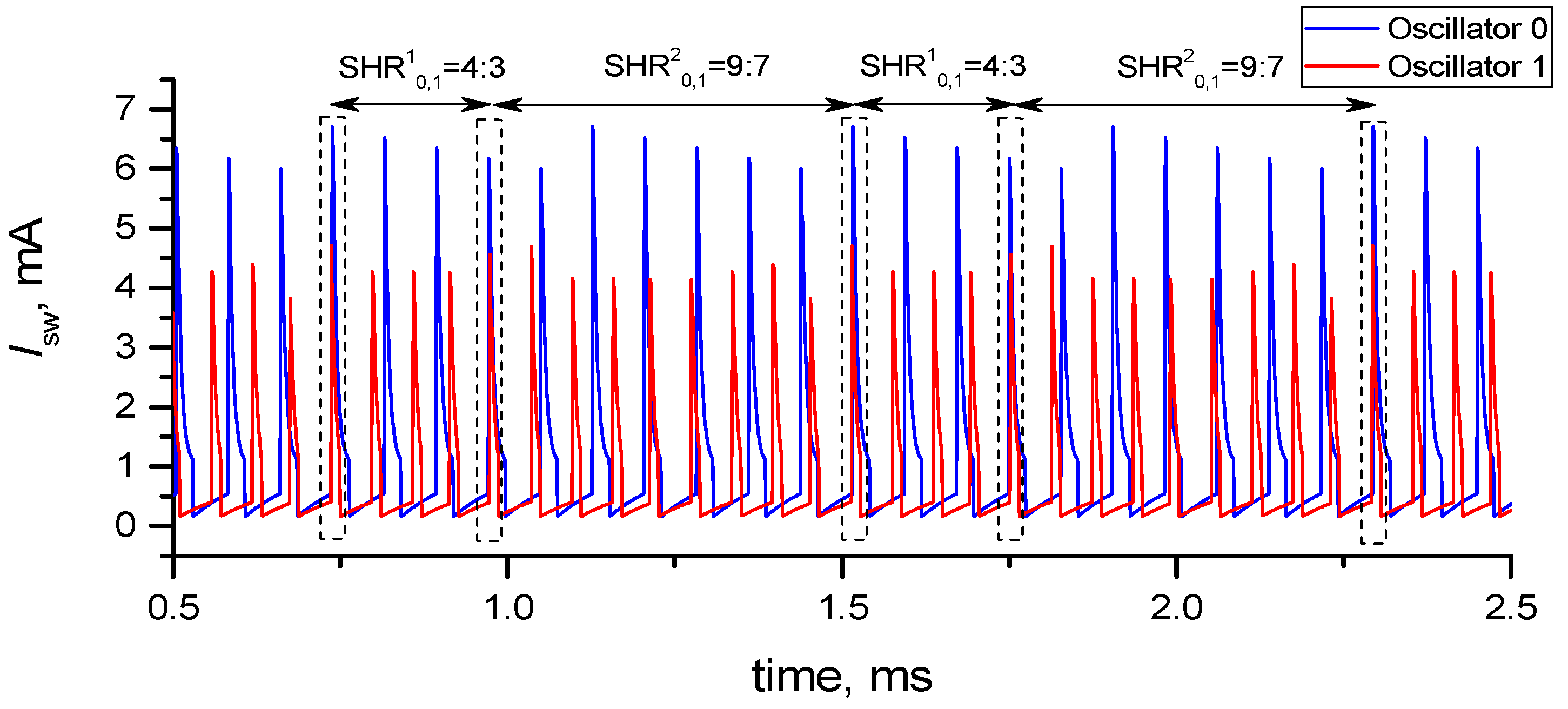
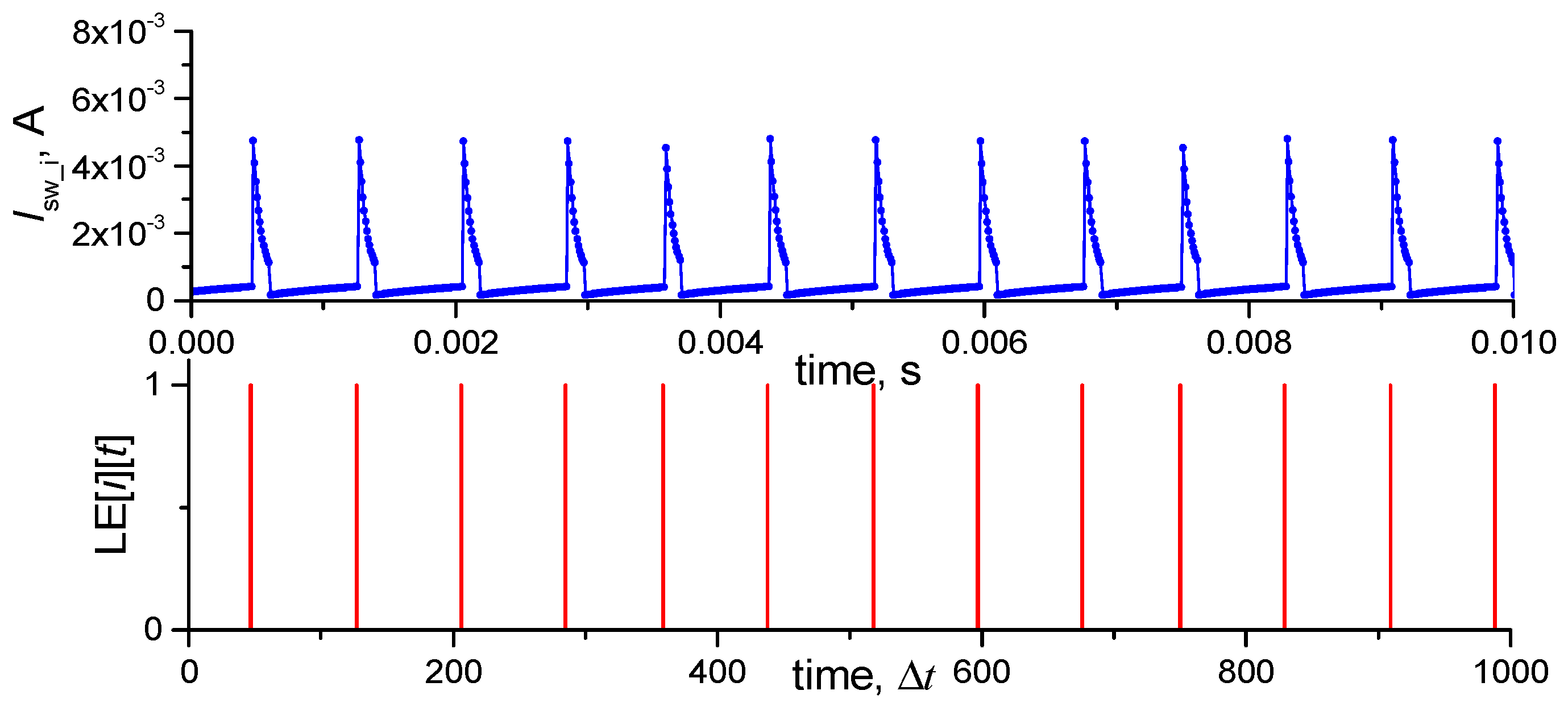
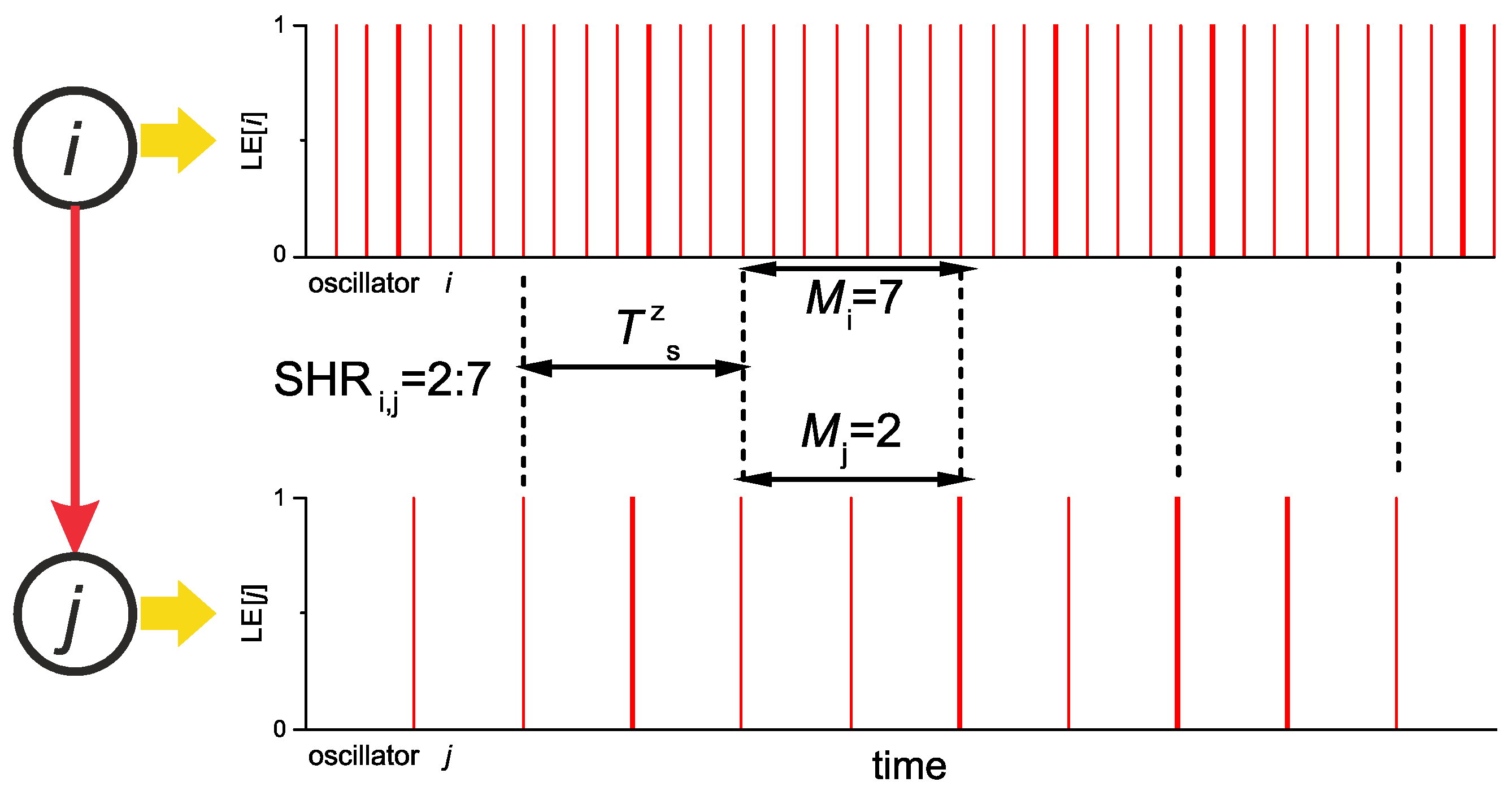
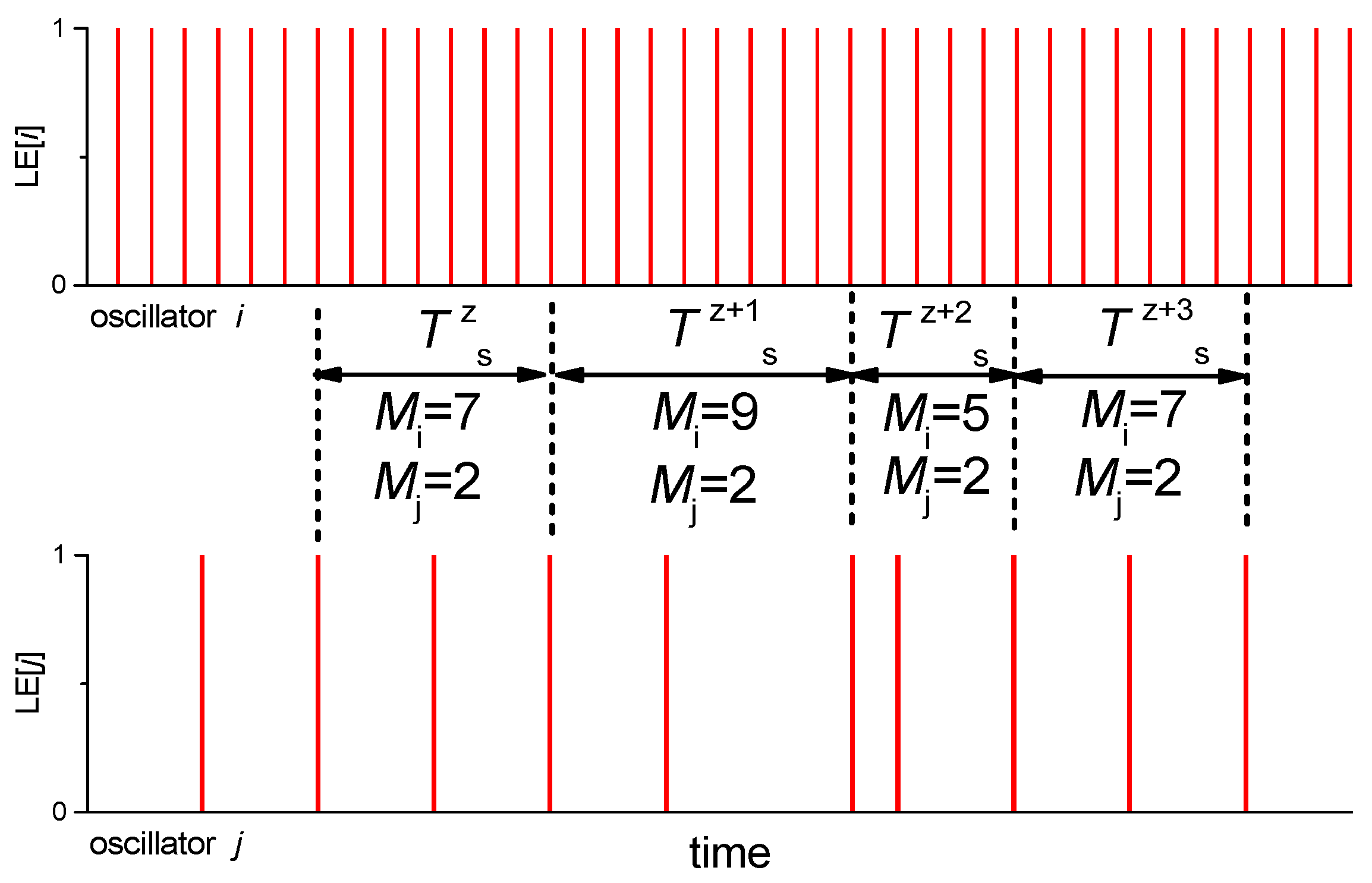
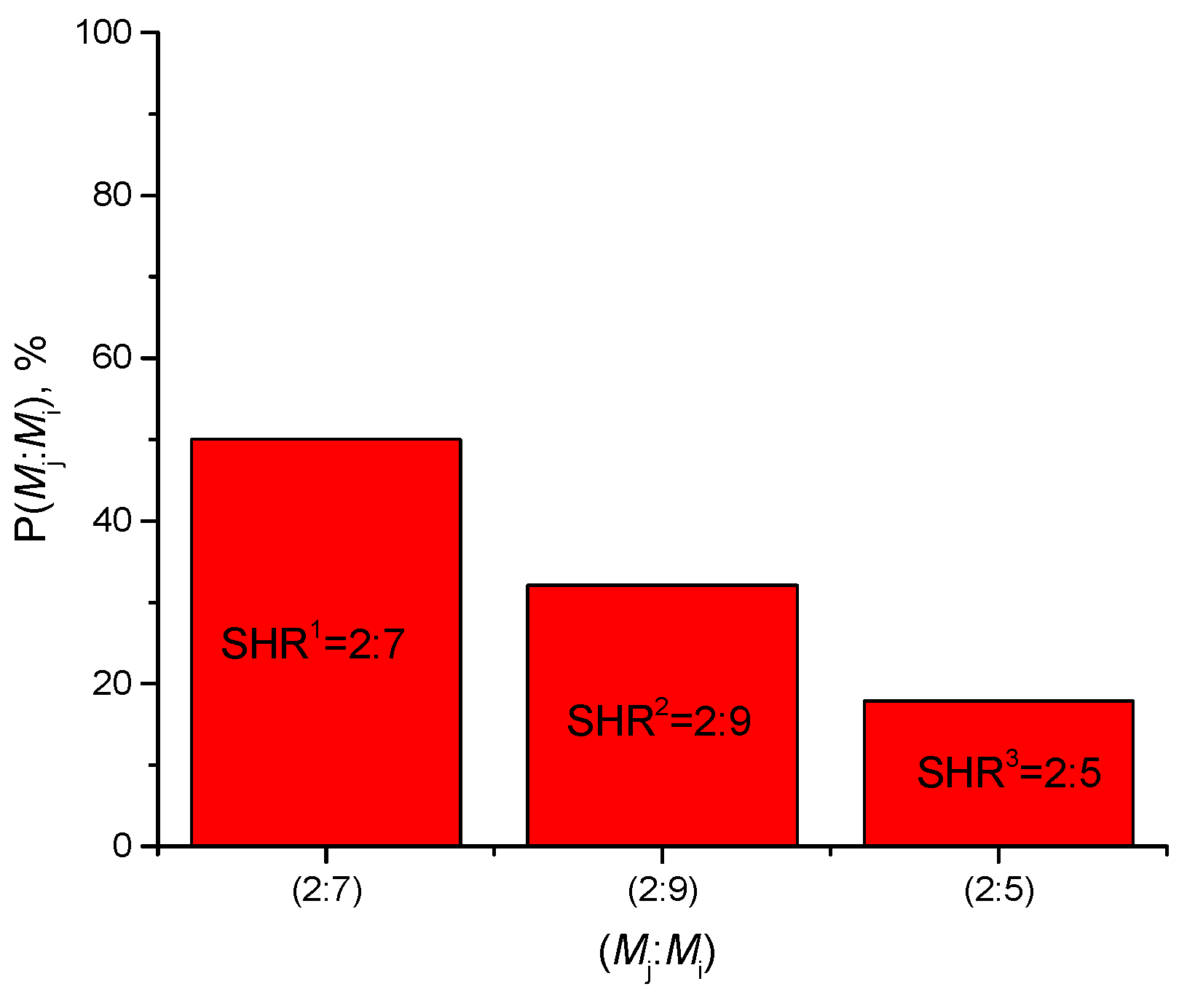
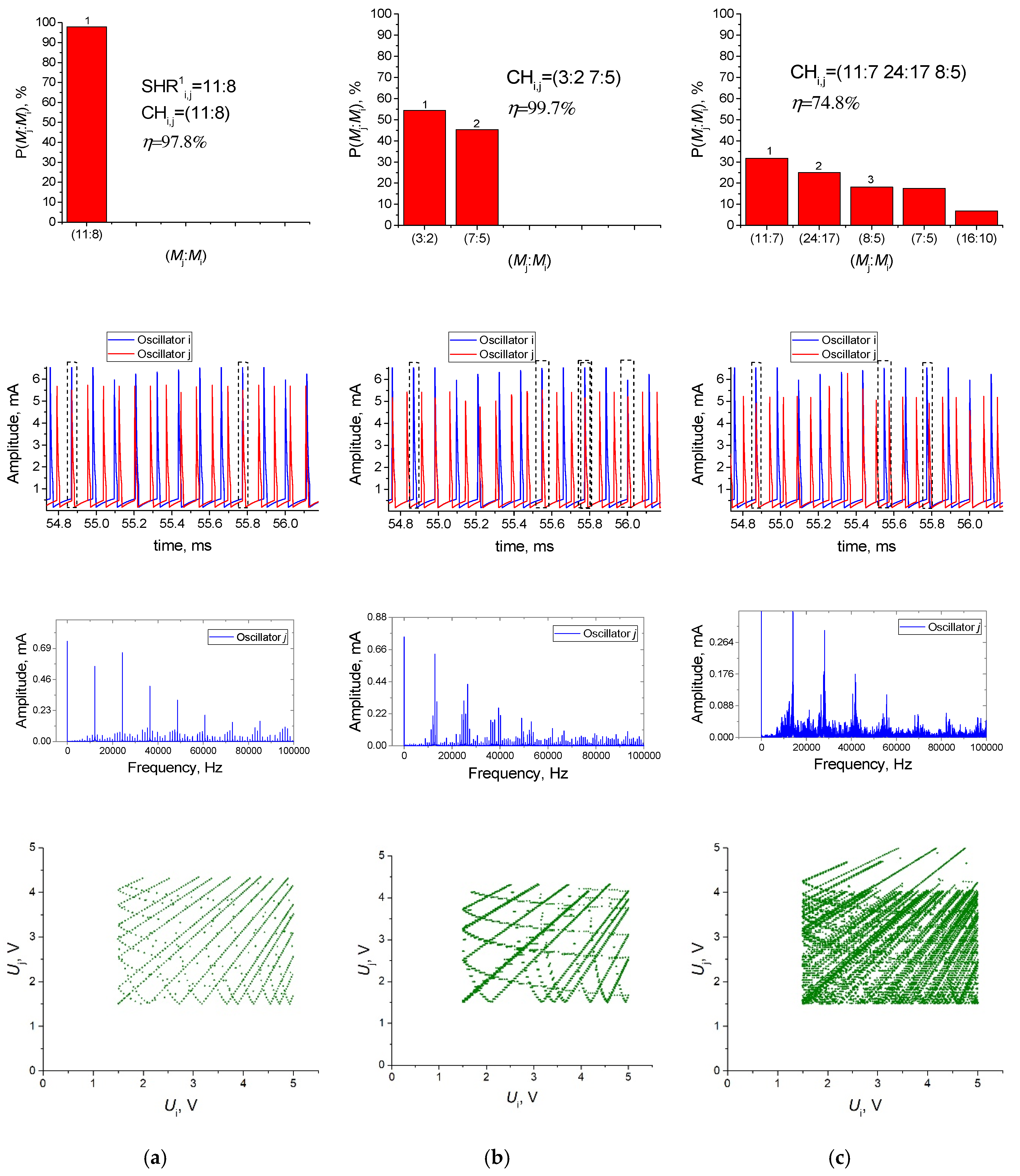
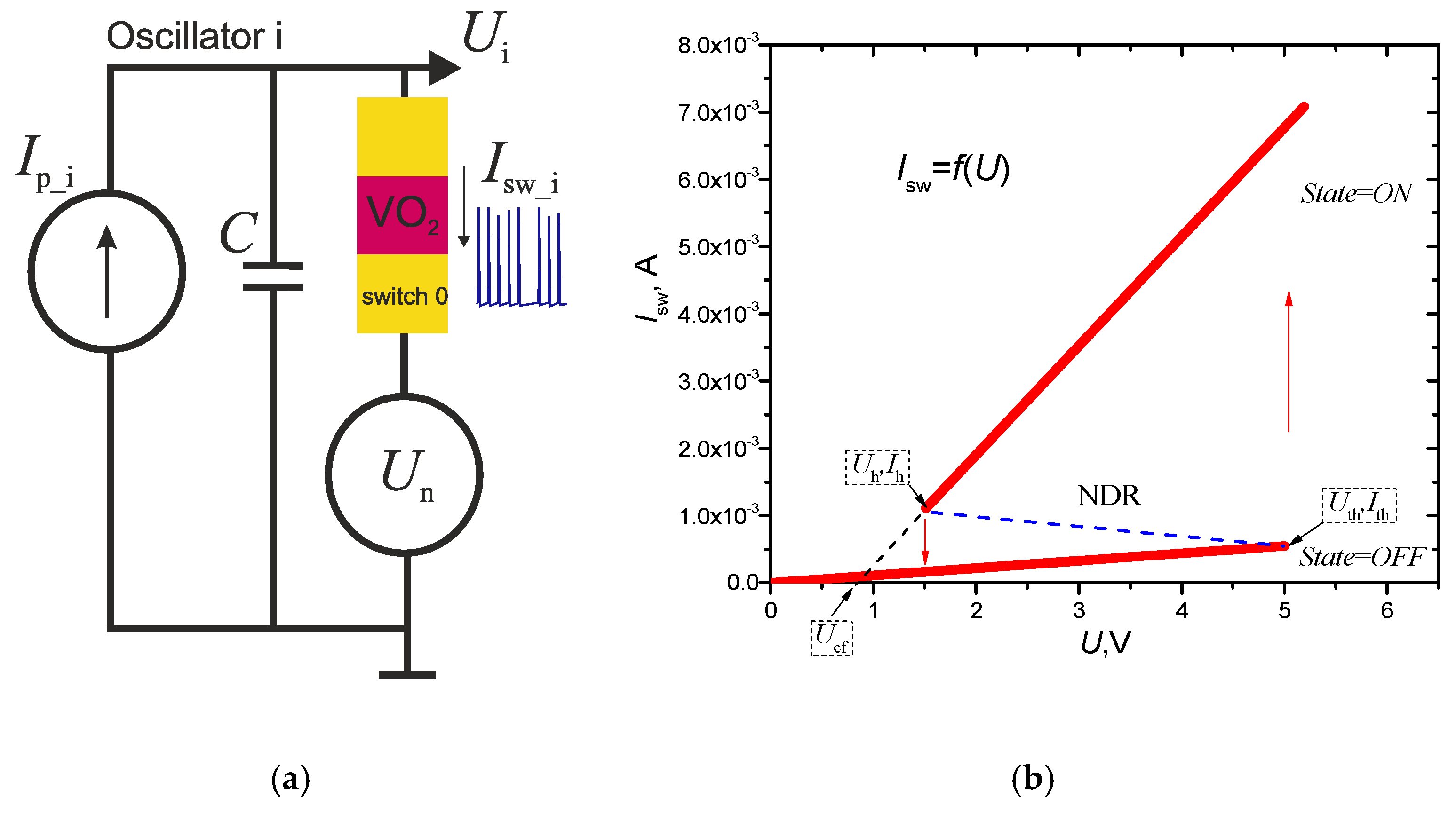
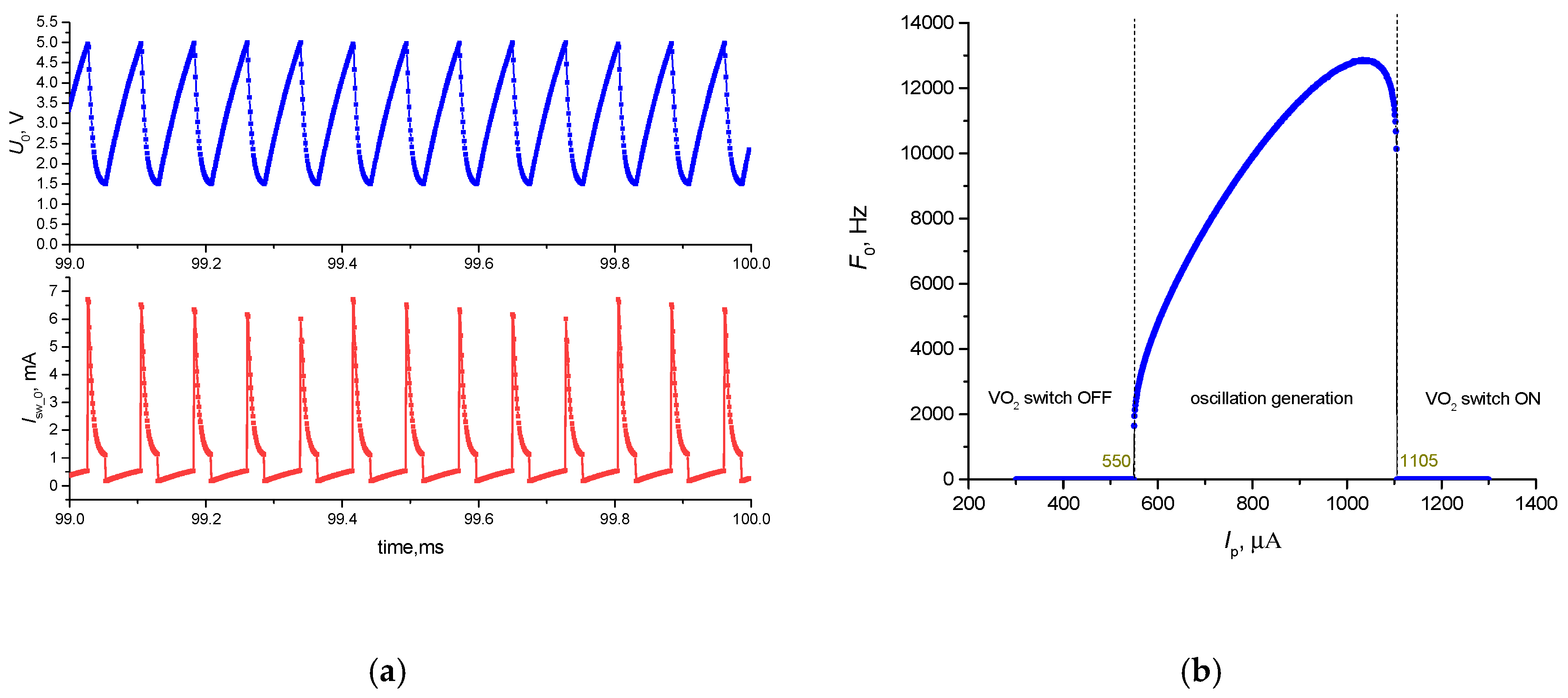
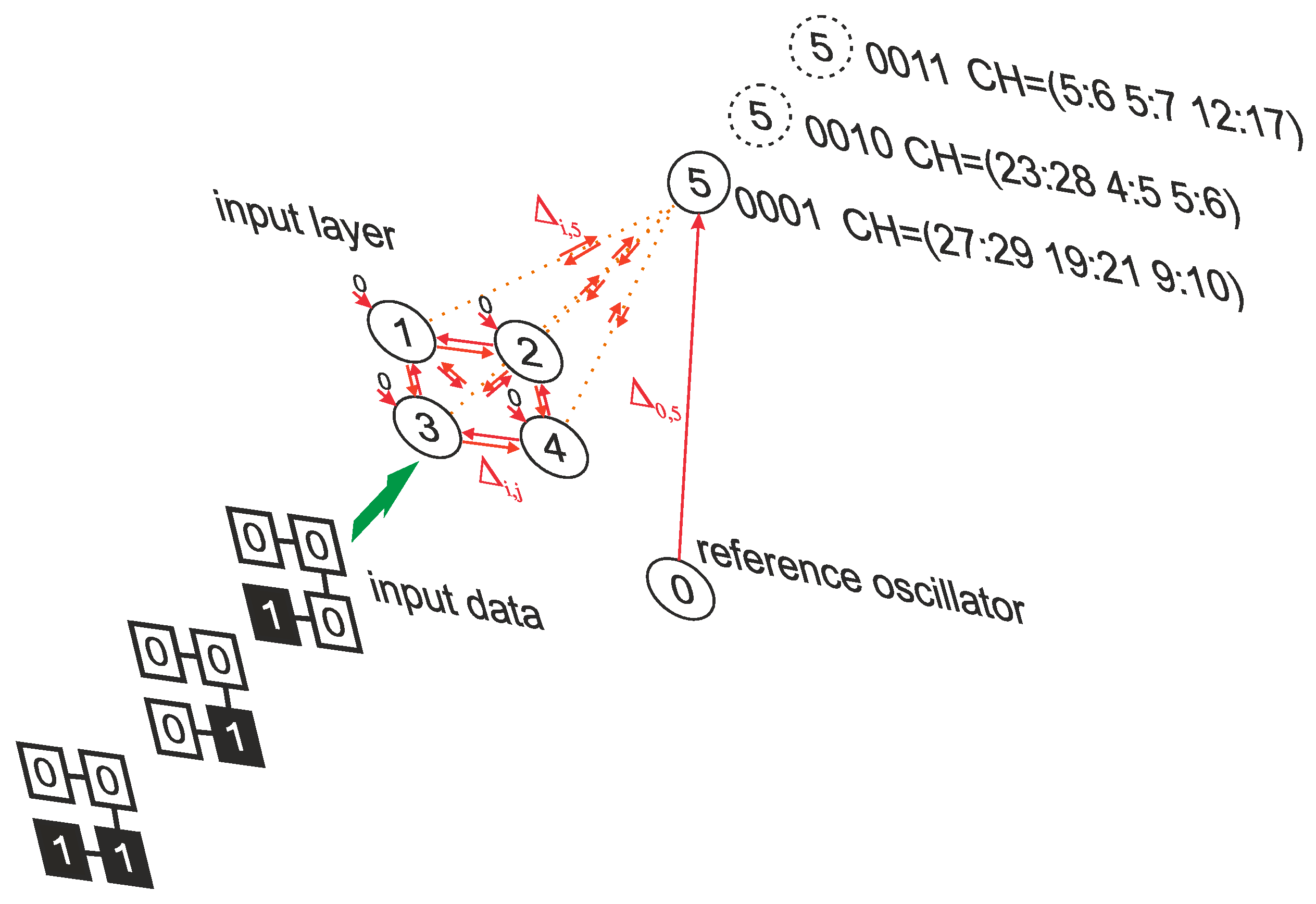
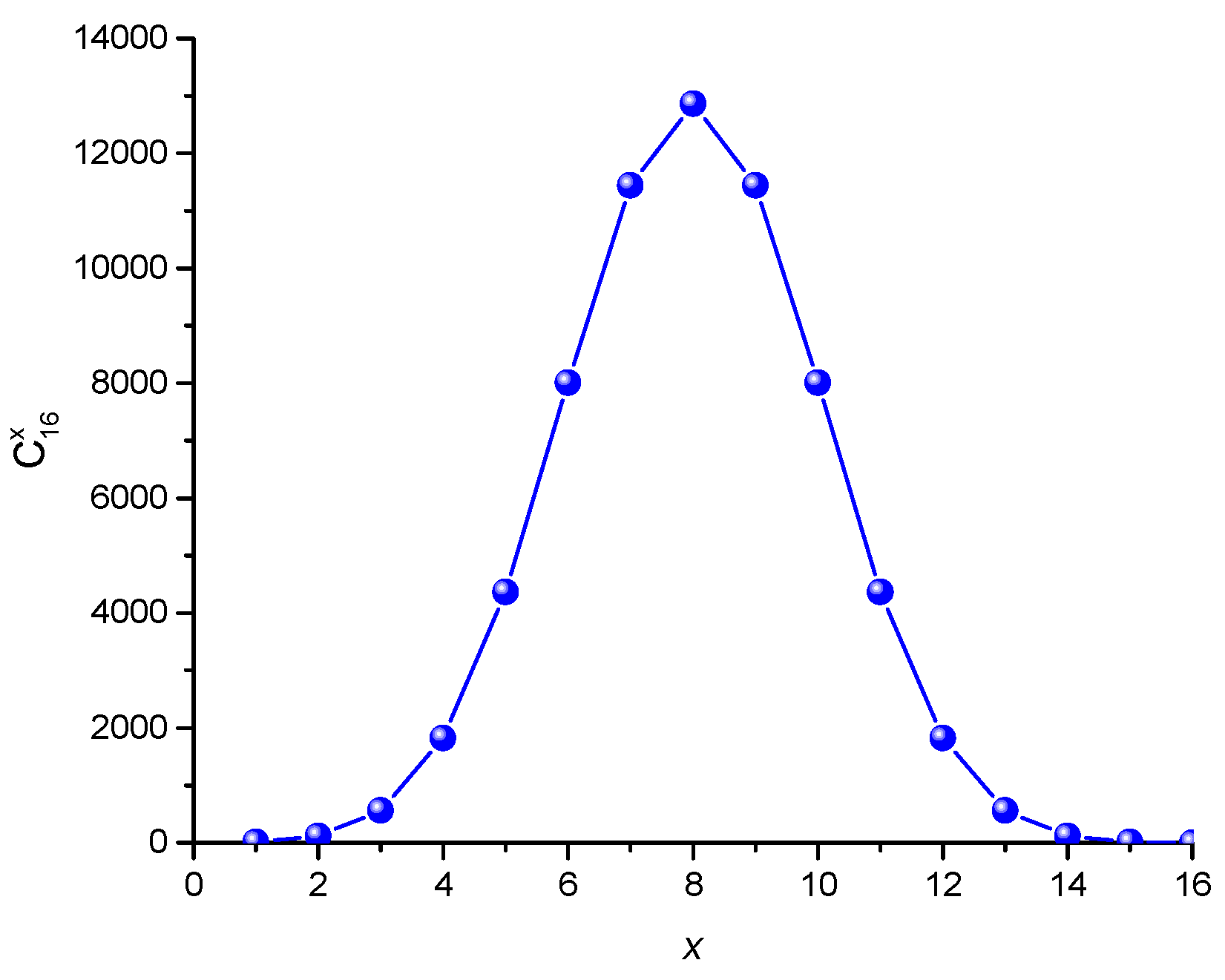
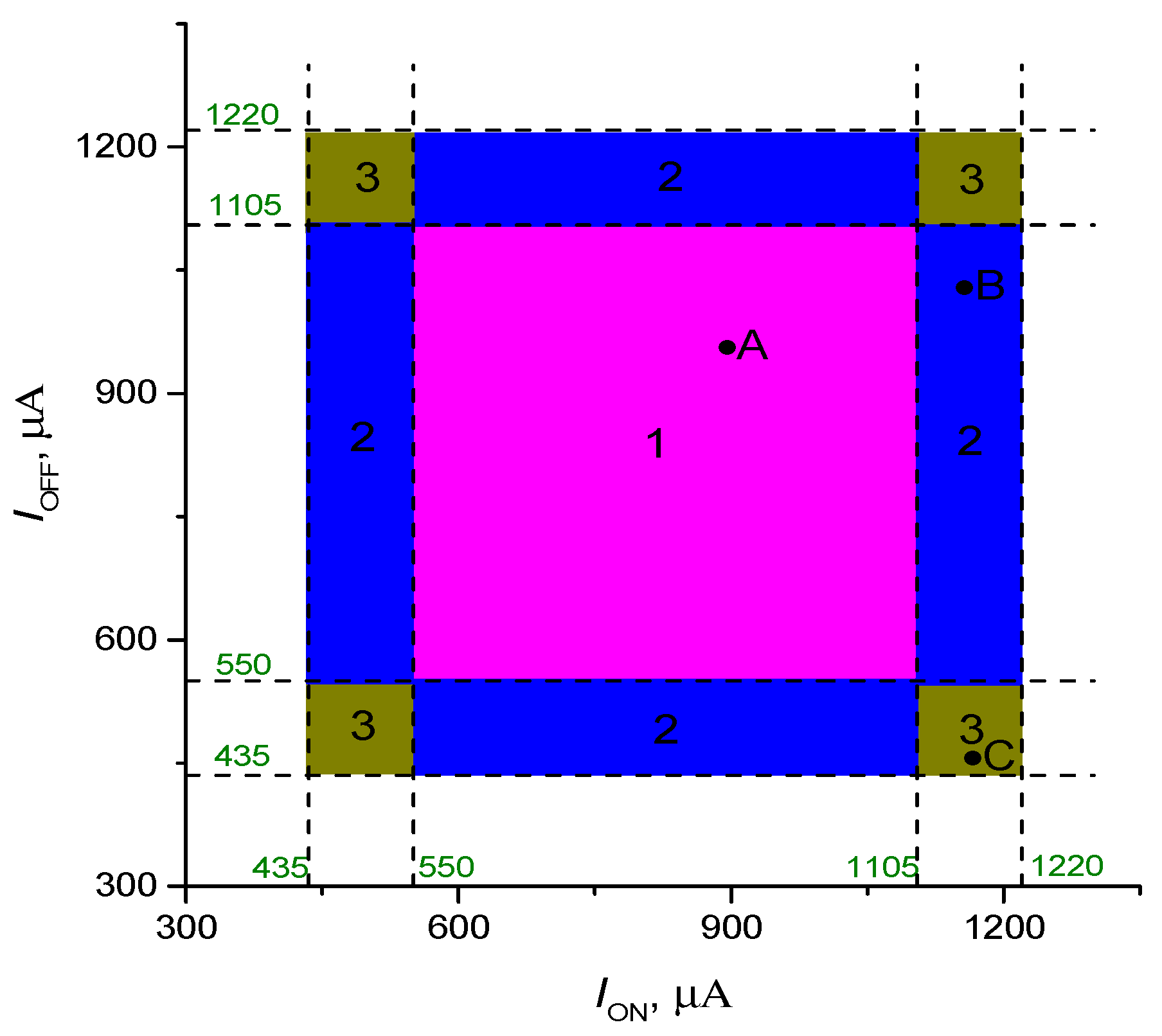
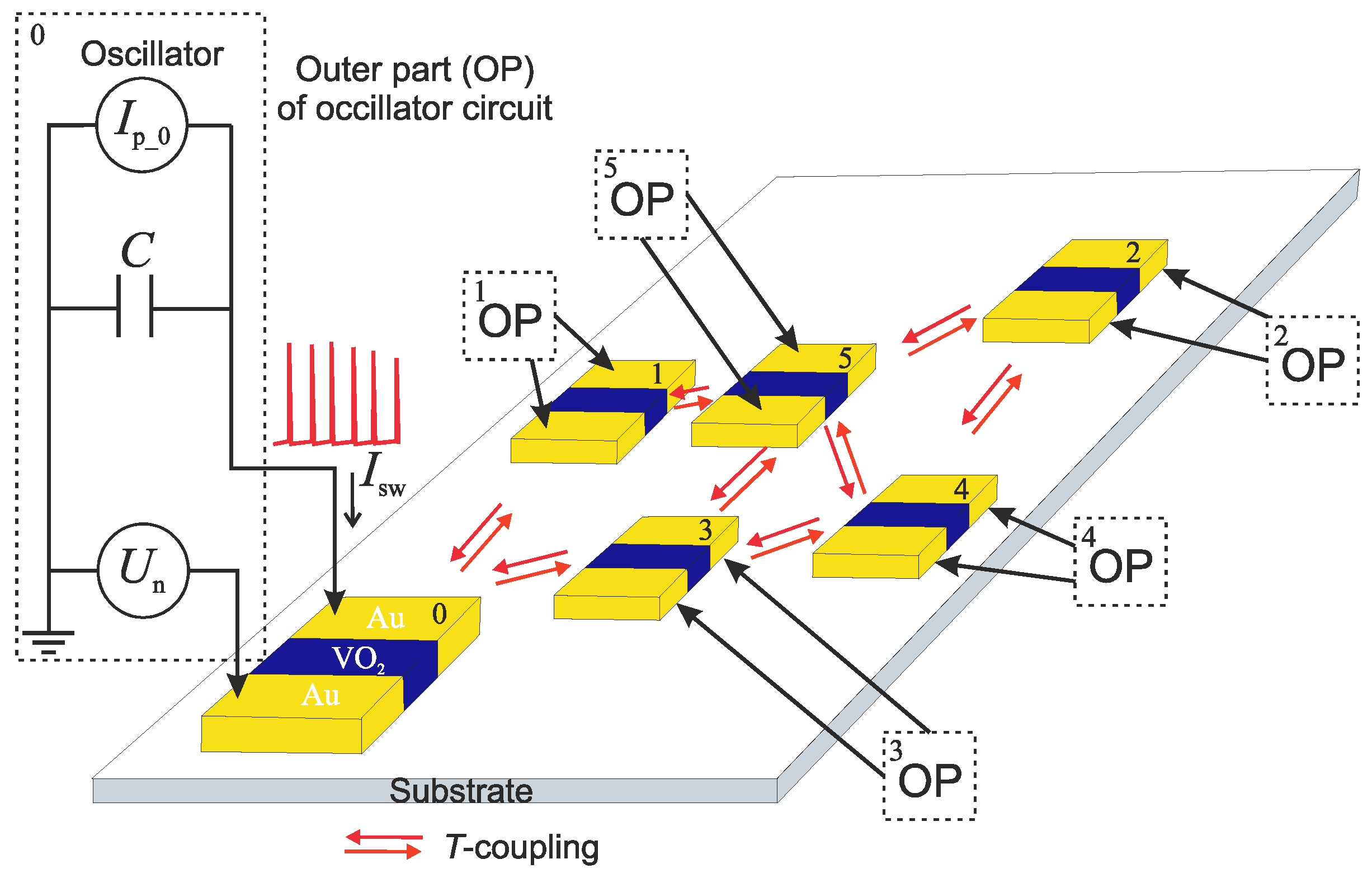
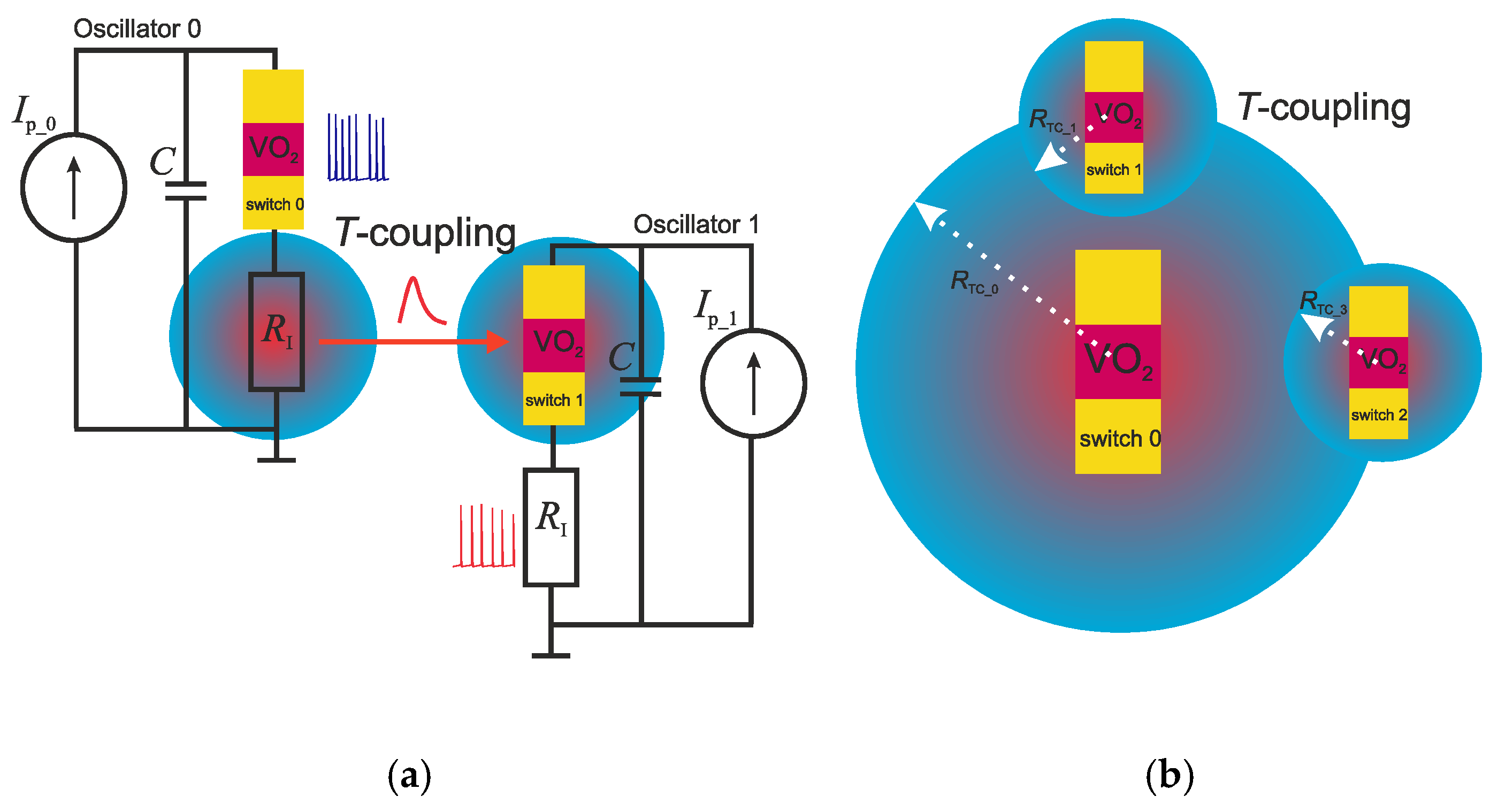
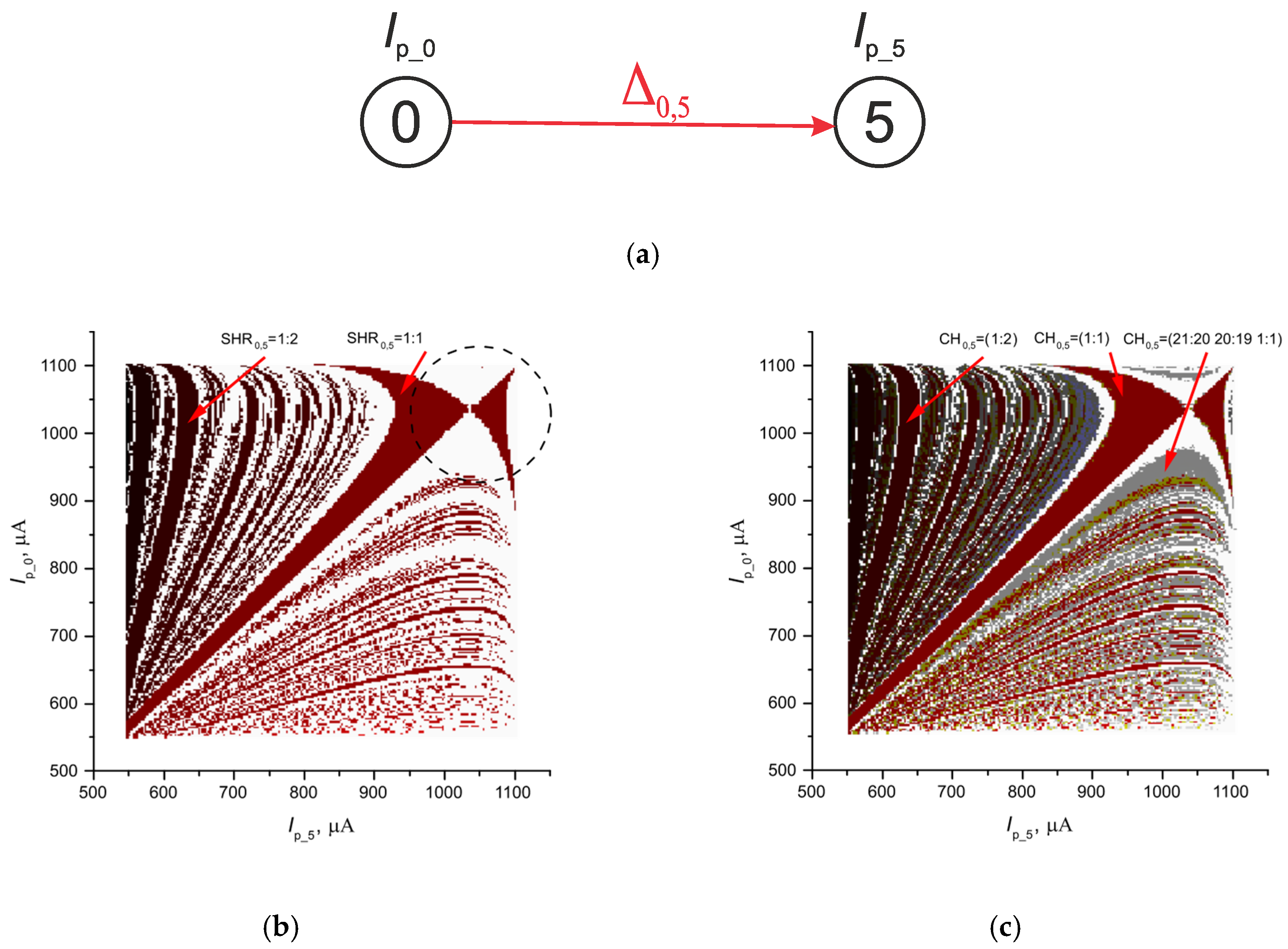
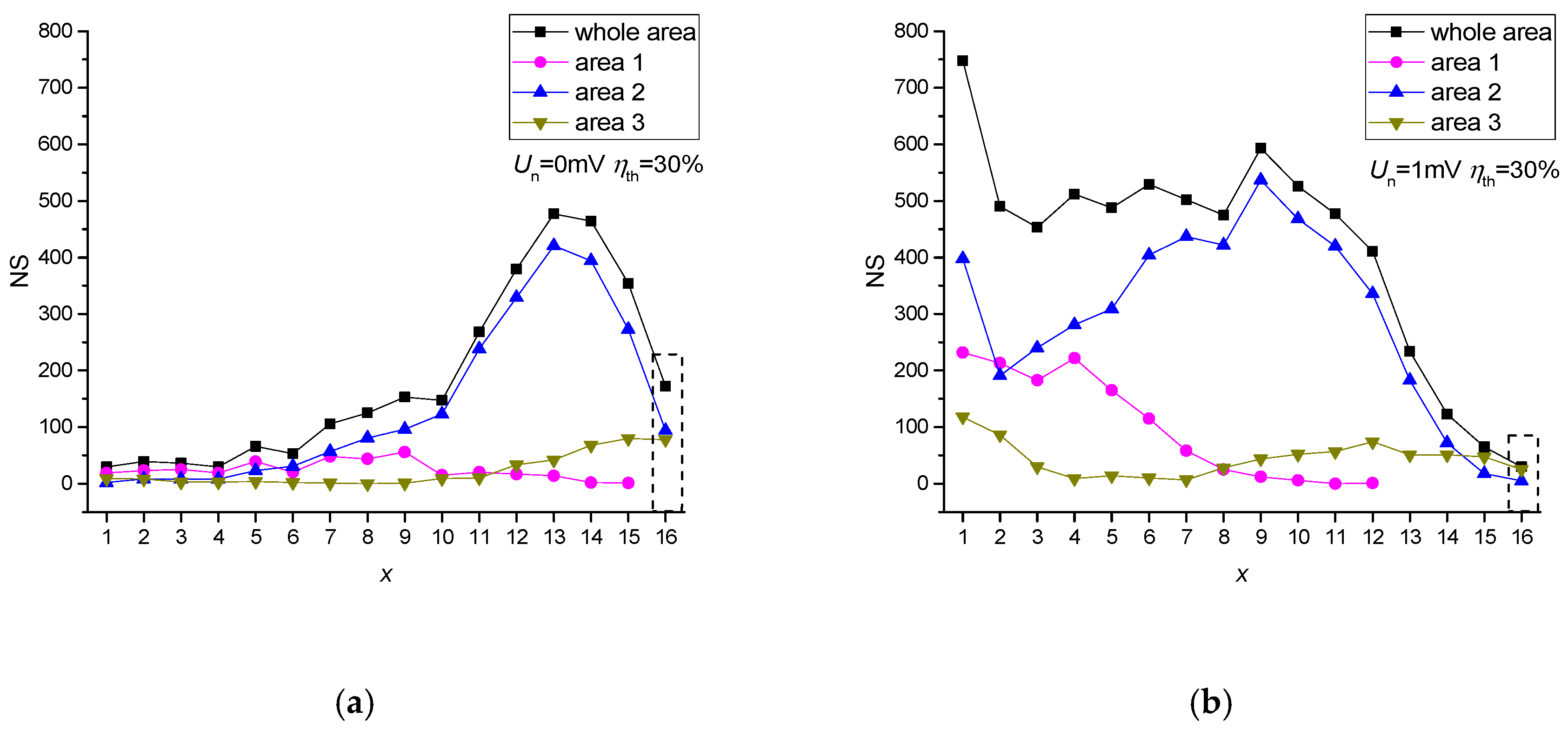
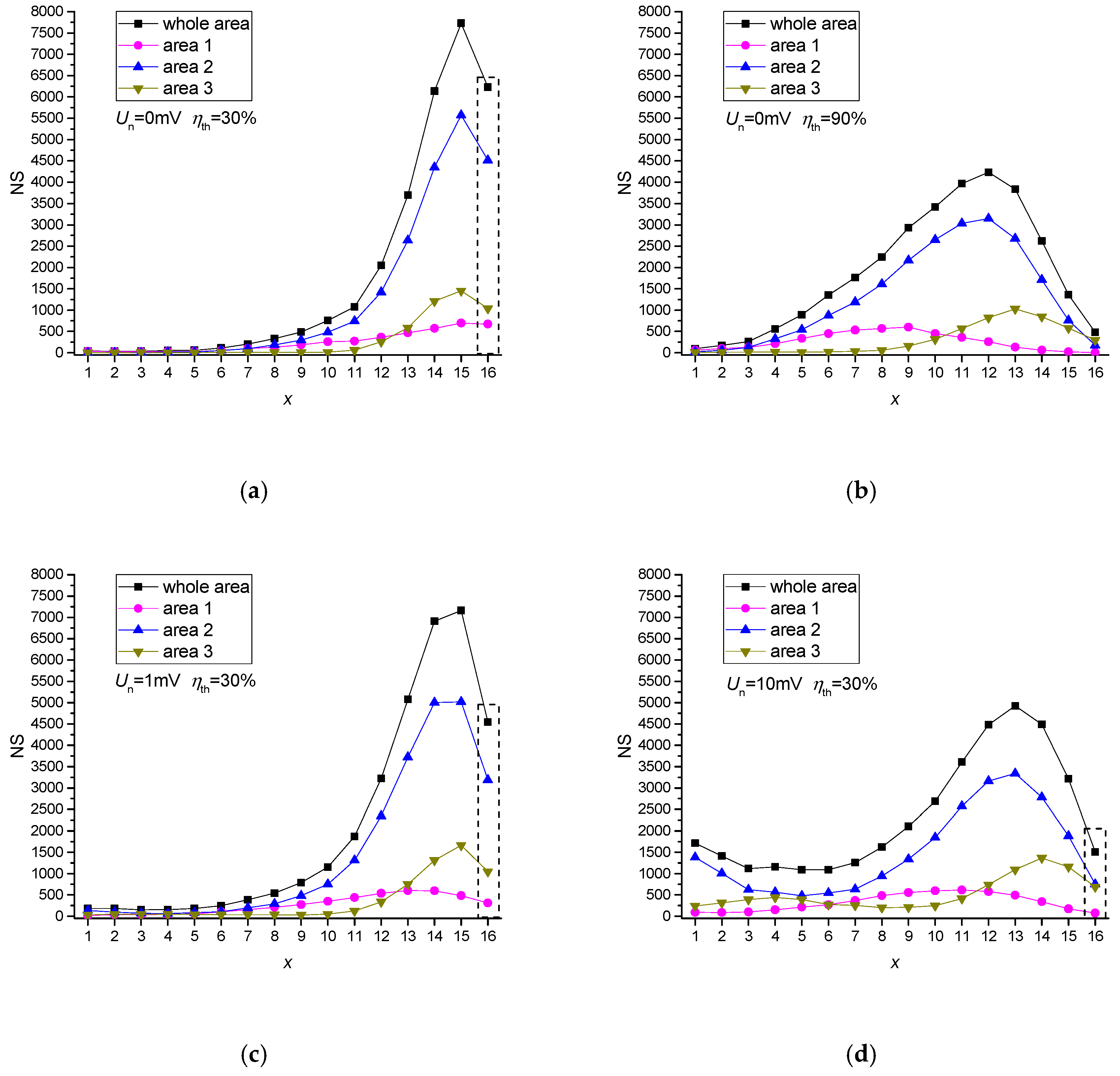
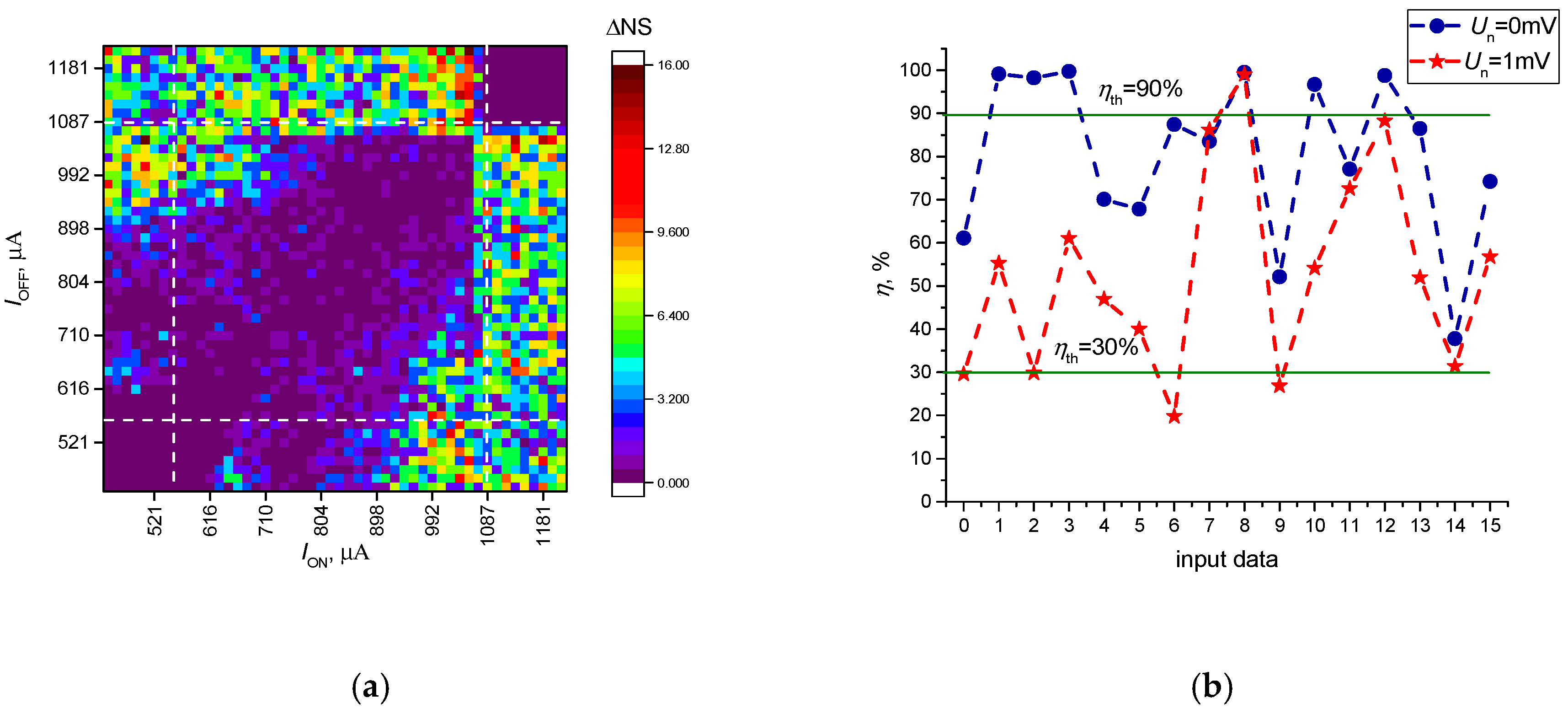
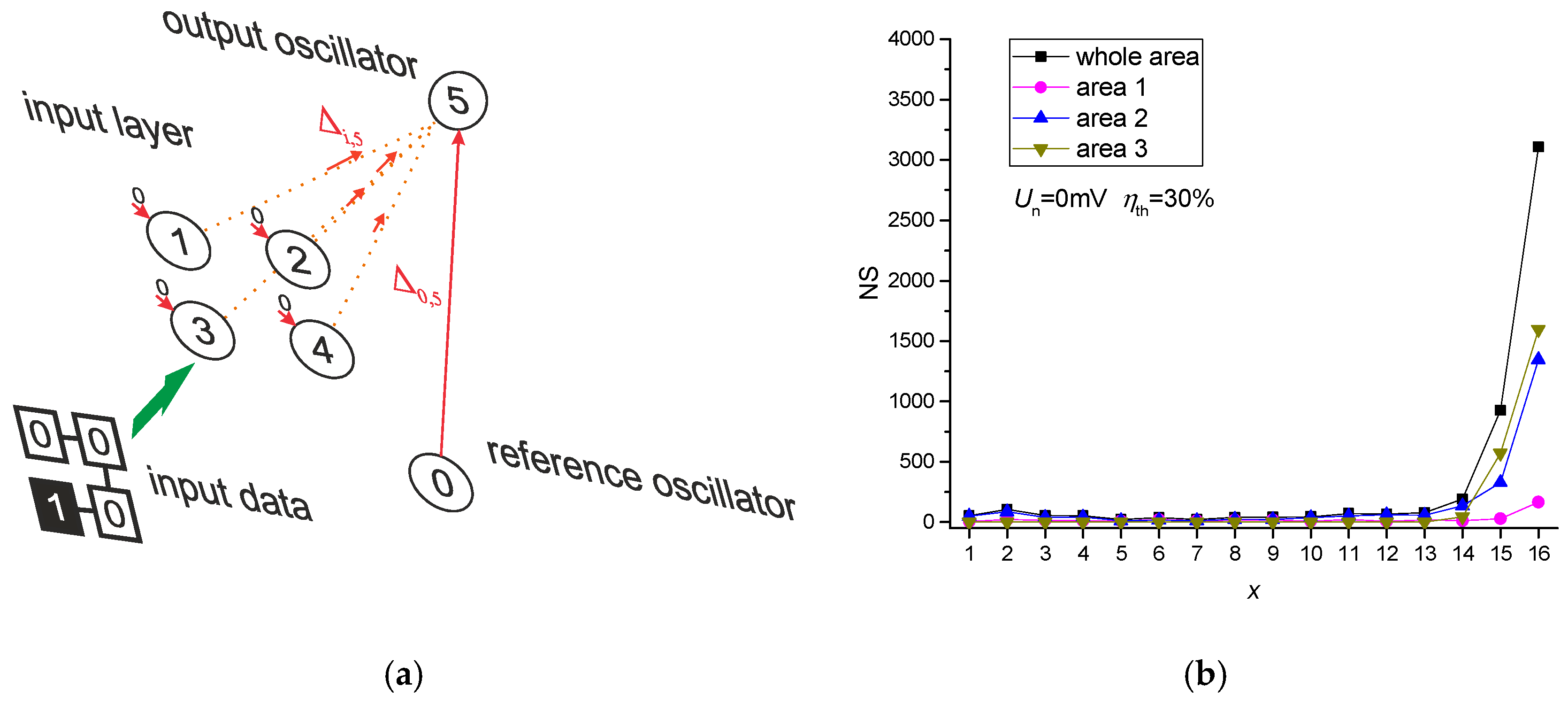
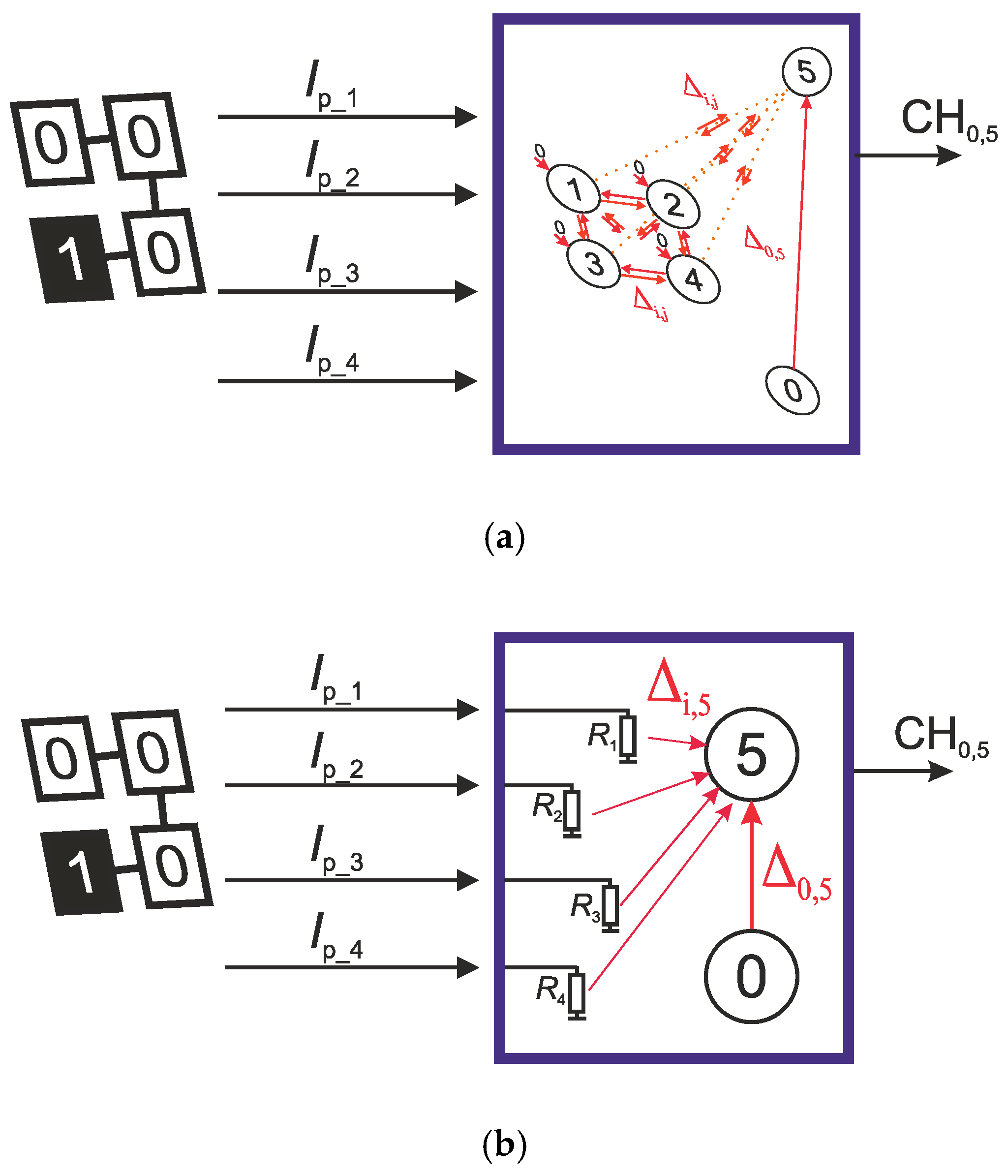
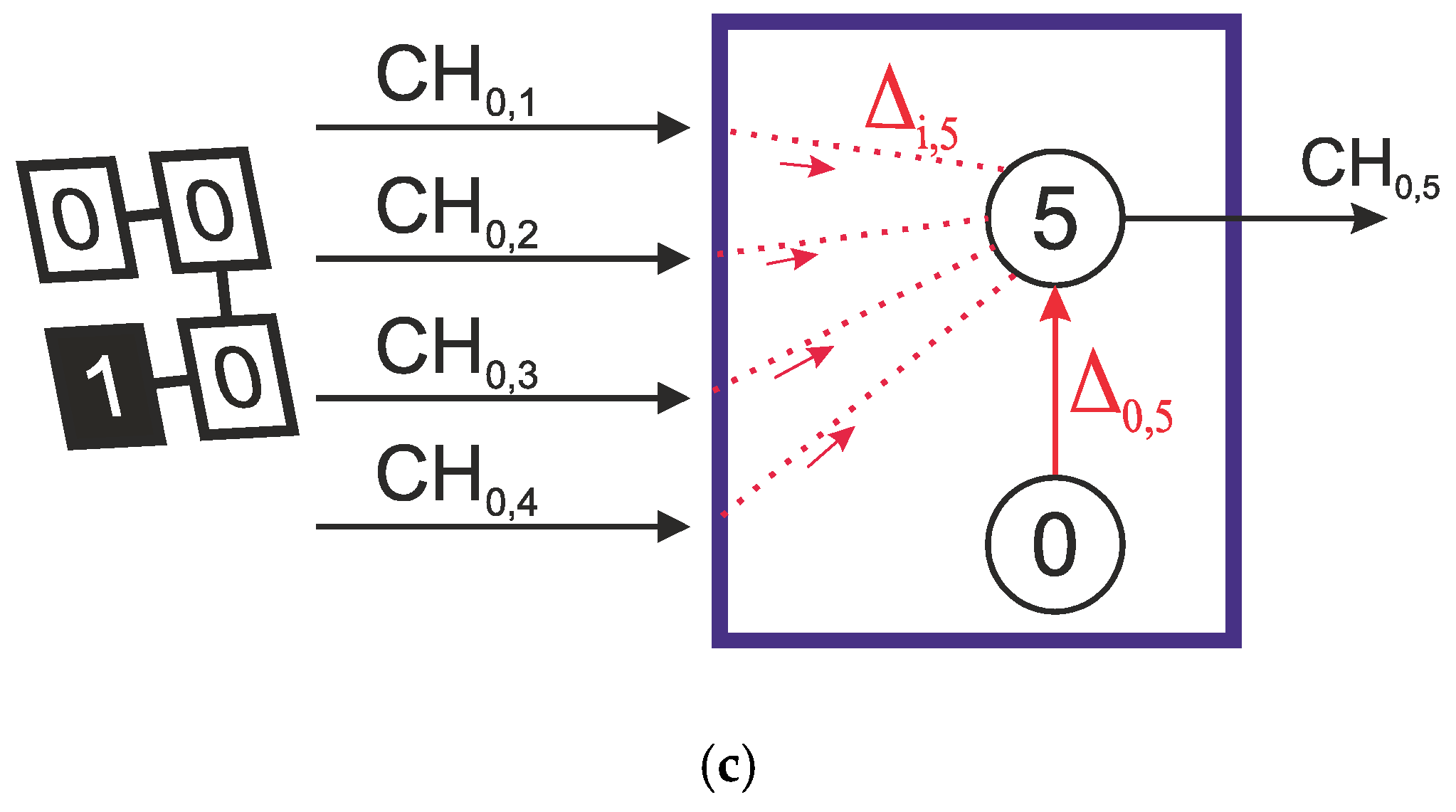
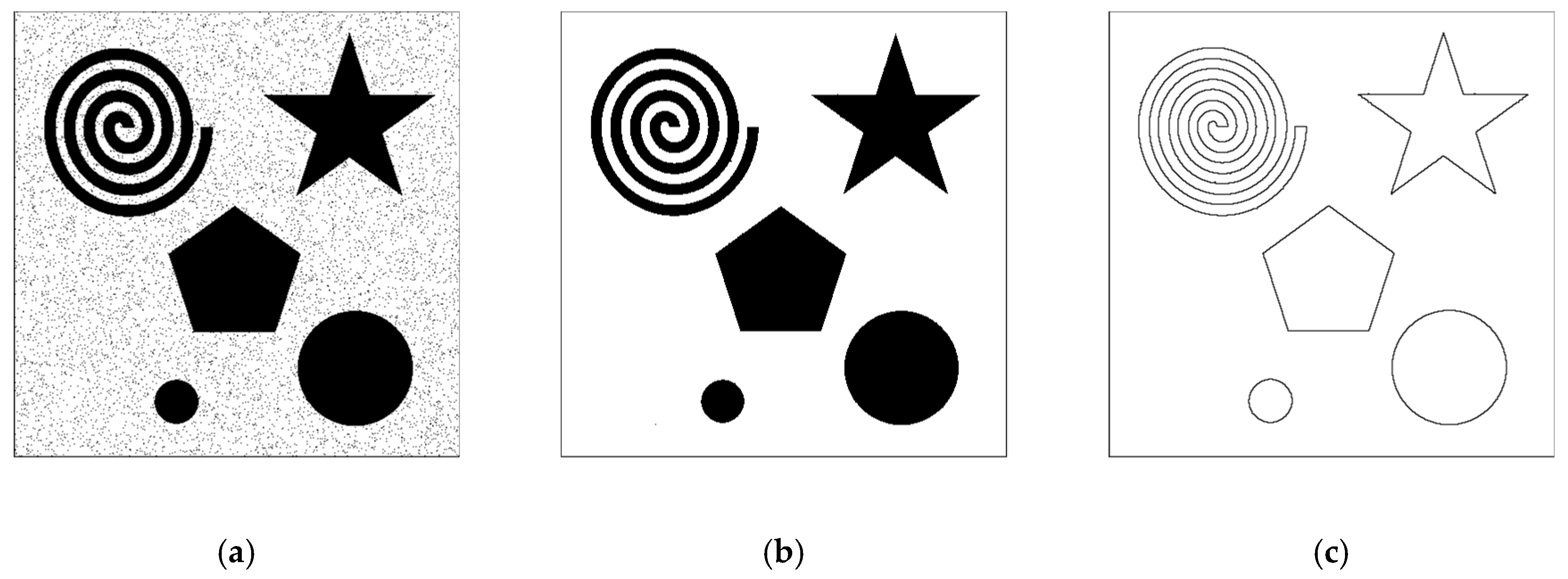
| High Order Synchronization | Chimeric Synchronization | |||||
|---|---|---|---|---|---|---|
| “1 of 1” | “2 of 2” | “16 of 16” | “1 of 1” | “2 of 2” | “16 of 16” | |
| Input data | SHR0,5 | SHR0,5 | SHR0,5 | CH0,5 | CH0,5 | CH0,5 |
| 0000 | - | - | 1:1 | (3:4) | - | (7:8 11:12 3:3) |
| 0001 | - | - | 9:7 | - | - | (27:29 19:21 9:10) |
| 0010 | - | - | 9:8 | - | - | (23:28 4:5 5:6) |
| 0011 | - | - | 10:7 | - | - | (5:6 5:7 12:17) |
| 0100 | - | - | 14:11 | - | - | (26:28 25:27 13:15) |
| 0101 | - | 1:1 | 3:2 | - | (13:11 6:5) | (46:48 25:27 6:7) |
| 0110 | - | - | 5:3 | - | - | (4:5 3:4 5:6) |
| 0111 | - | - | 8:5 | - | (19:17 29:26) | (8:10 5:6 9:11) |
| 1000 | - | - | 20:17 | - | - | (5:6 7:8 1:1) |
| 1001 | - | - | 2:1 | - | - | (42:43 39:40 17:19) |
| 1010 | - | - | 11:7 | - | - | (5:7 12:17 9:11) |
| 1011 | - | - | 15:7 | - | - | (5:7 12:17 10:12) |
| 1100 | - | - | 15:8 | - | - | (9:10 13:14 1:1) |
| 1101 | - | 7:8 | 11:5 | - | - | (9:10 6:7 3:3) |
| 1110 | - | - | 19:9 | - | - | (11:15 8:11 5:7) |
| 1111 | 4:3 | - | 5:2 | - | - | (8:11 5:7) |
| Filter 1 | Filter 2 | Filter 1 | Filter 2 | ||
|---|---|---|---|---|---|
| Input Data | Color | Color | Input Data | Color | Color |
| 0000 | White | White | 1000 | White | Black |
| 0001 | White | Black | 1001 | White | Black |
| 0010 | White | Black | 1010 | White | Black |
| 0011 | White | Black | 1011 | White | Black |
| 0100 | White | Black | 1100 | White | Black |
| 0101 | White | Black | 1101 | White | Black |
| 0110 | White | Black | 1110 | White | Black |
| 0111 | White | Black | 1111 | Black | White |
© 2019 by the author. Licensee MDPI, Basel, Switzerland. This article is an open access article distributed under the terms and conditions of the Creative Commons Attribution (CC BY) license (http://creativecommons.org/licenses/by/4.0/).
Share and Cite
Velichko, A. A Method for Evaluating Chimeric Synchronization of Coupled Oscillators and Its Application for Creating a Neural Network Information Converter. Electronics 2019, 8, 756. https://doi.org/10.3390/electronics8070756
Velichko A. A Method for Evaluating Chimeric Synchronization of Coupled Oscillators and Its Application for Creating a Neural Network Information Converter. Electronics. 2019; 8(7):756. https://doi.org/10.3390/electronics8070756
Chicago/Turabian StyleVelichko, Andrei. 2019. "A Method for Evaluating Chimeric Synchronization of Coupled Oscillators and Its Application for Creating a Neural Network Information Converter" Electronics 8, no. 7: 756. https://doi.org/10.3390/electronics8070756
APA StyleVelichko, A. (2019). A Method for Evaluating Chimeric Synchronization of Coupled Oscillators and Its Application for Creating a Neural Network Information Converter. Electronics, 8(7), 756. https://doi.org/10.3390/electronics8070756




